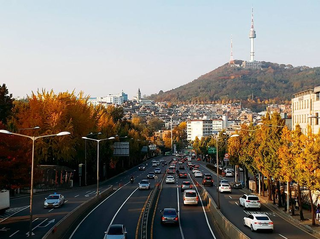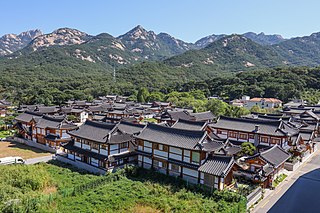
Yongsan District is one of the 25 districts of Seoul, South Korea.

Mokdong Hyperion is a group of three residential buildings located in the Mok-dong, Yangcheon-gu district of Seoul, South Korea, completed in 2003. The tallest of which, Tower A, is 69 floors and 256 metres (840 ft) high, making it the fifth tallest building in Seoul and the world's 214th tallest building. The towers are used as residential housing. Tower A is the world's 48th tallest residential building. Below the building is a Hyundai Department store, a chain of high end department stores in South Korea. At the time of its completion, the building was the tallest in the country but was surpassed by Samsung Tower Palace 3 – Tower G in 2004.

Yeongdeungpo District is an administrative district in southwest Seoul, South Korea. Although the origin of the name is uncertain, the first two syllables are thought to be from "yeongdeung" (靈登) or "divine ascent", a shamanic rite. The third syllable is "po", representing the bank of a river (浦), referring to the district's position on the Han River. The 2006 population was 408,819.

Gangbuk District (Gangbuk-gu) is one of the 25 gu which make up the city of Seoul, South Korea. Its name is derived from it being located at the north of Han river. It was created from neighbouring Dobong District (도봉구) in 1995. The current mayor is Park Gyeom-su.

Sindorim station is a station on Seoul Subway Line 1 and Line 2 (underground). It is also the southeastern terminus of Line 2's Sinjeong Branch to Kkachisan. The station is located at the northern edge of Sindorim-dong, Guro-gu, Seoul, on the border with Yeongdeungpo-gu.

Yangcheon-gu Office Station is a station on the Sinjeong Branch of the Seoul Subway Line 2. This station is located in Sinjeong-dong, Yangcheon-gu, Seoul. It is named after the city hall of Yangcheon-gu district; Yangcheon means "sunny stream".

Guro District (Guro-gu) is a district of Seoul, South Korea, which was separated from Yeongdeungpo District on April 1, 1980. Located in the southwestern part of the city, where besides Yangcheon District and Geumcheon District Guro District has an important position as a transport link which contains railroads, land routes from the rest of Seoul to the south of the country. The Gyeongbu and Gyeongin railway lines connect Seoul to Busan and Incheon. In addition, Seoul Metropolitan Subway lines 1, 2, and 7, and major highways intersect in Guro District.

Eunpyeong District is one of the 25 districts of Seoul, South Korea.

Seongdong District (Seongdong-gu) is one of the 25 gu which make up the city of Seoul, South Korea. It is situated on the north bank of the Han River. It is divided into 20 dong (neighbourhoods).

Gangseo District (Gangseo-gu) is one of the 25 wards (gu) of Seoul, South Korea. It is located on the south side of the Han River. Gimpo Airport is in Gonghang-dong, where many flights fly to cities like Busan, Jeju, and Gwangju.

Gwangjin District is one of the 25 districts of Seoul, South Korea. It is located on the north bank of the Han River on the eastern end of Seoul. The district was split from the neighboring Seongdong District in 1995.

Jungnang District (Jungnang-gu) is one of the 25 gu, or districts, of Seoul, South Korea. It is located on the north side of the Han River.

The Mokdong Stadium is a South Korean sports complex located in Mok-dong, Yangcheon-gu, Seoul. It consists of a multi-purpose stadium, a baseball stadium, and an artificial ice rink. It was opened on 14 November 1989. The main stadium hosted K League football matches from 1996 to 2001.

Dogok-dong is an affluent ward of Gangnam-gu in Seoul, South Korea. It is home to high-end residential homes including the Samsung Tower Palace, a luxury residential complex which contains the eleventh-tallest building in South Korea.

Mok-dong (Korean: 목동) is a ward of Yangcheon-gu, located in the west of Seoul, South Korea. Commonly referred to as a "special education district", the upper-middle to upper-class neighborhood is best known for its abundance of private institutions, or Hagwons, as well as quality public schools. It is also home to the headquarters of two broadcasting corporations, SBS and CBS. Also situated in Mok-dong are the Hyperion Towers, the tallest of which is 69 stories or 256 metres (840 ft) tall. The tallest tower, Tower A, is the fifth tallest skyscraper in Seoul and one of the tallest residential buildings globally. During the Joseon Dynasty, it was used as a ranch where horses were grazed by many trees and was transformed into a wooden area.
Sinwol-dong is a dong, neighbourhood of Yangcheon-gu in Seoul, South Korea.
Sinjeong-dong is a dong, neighbourhood of the Mapo-gu district in Seoul, South Korea.
Sinjeong-dong is a dong, neighbourhood of Yangcheon-gu in Seoul, South Korea.

Pyeongtaek–Paju Expressway is an expressway in South Korea. It connects Pyeongtaek to Paju in Gyeonggi Province. The expressway's route number is 17, which it shares with the Iksan–Pyeongtaek Expressway. This expressway overlaps with the Capital Region Second Ring Expressway at Hwaseong.




















